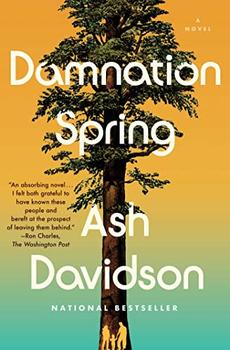Book Club Discussion Questions
In a book club? Subscribe to our Book Club Newsletter!
For supplemental discussion material see our Beyond the Book article, Poison from the Sky in Oregon and our BookBrowse Review of Damnation Spring.
Please be aware that this discussion guide will contain spoilers!
- Lark says of Rich, "Not a lot of guys are born to do something." What is Lark referring to? In your opinion, what
role does a sense of "destiny" play in Rich's decision to take a risk on 24-7 Ridge?
- Consider the role Daniel played in Colleen's young adulthood. Why does she feel drawn to him when he first
returns to Klamath? To Colleen, what does Daniel represent in her life?
- In the beginning of the novel, Colleen is reeling after her latest miscarriage and feels resentful of her sister, Enid,
who now has six children—including her youngest, the miraculously docile Alsea. How does Colleen's notion of
Enid as the luckier of the two become more complicated as the novel progresses? By the end of the novel, how
has the sisters' relationship to one another changed?
- On page 50, Daniel's words replay in Colleen's head: "People think it's just about trees, or it's just about fish. By
the time they realize it's about them, it's too late." How does the interconnectedness of people and the environment play out in the novel? Do you think Daniel's prediction—that the risks of environmental degradation will be
evident only once it's too late—comes true for the community of Klamath? Why or why not?
- Throughout the novel, water—flood waters, mudslides, contaminated creeks—poses as much a danger to all
Klamath residents as the occupational hazards of forestry do to the loggers. How do you understand the role of
water in this story?
- Rich observes about Merle's husky, "A dog wasn't a man. It didn't choose which sonofabitch owned him."
Consider the subsequent revelations about Eugene's actions in light of Rich's observation. In your opinion, is Eugene's financial dependence on Sanderson a justification for his behavior, or not?
- Consider Colleen's reluctance to tell Rich about the tap water collection jars, and Rich's insistence on keeping
the news about his purchase of 24-7 Ridge a secret from Colleen. Why do you think these characters repeatedly
hesitate to confide in one another? In your opinion, what are some events and developments that finally lead to
more openness between them, and why?
- On page 295, Pete says to Rich "[A] woman'll lift a car if her kid's under it." Mothers—and in particular Helen
and Colleen—are among the most vocal and active in the effort to uncover the truth about the health implications
of Sanderson's herbicide sprays. Why is this? What role does motherly love and heartbreak play in driving the
investigation forward? How might the novel have been different if the experiences of the women in the community were less central?
- During his speech at the hearing, Rich says "You scratch a logger, you better believe you'll find an 'enviro-mentalist' underneath." What does Rich mean by this? What do the loggers, the Yurok fishermen, and the environmentalists have in common? How do their perspectives differ?
- At the dentist's office in Coos Bay, Rich is finally relieved of the toothache he's had since the beginning of the
novel. In addition, he at last finds closure to his relationship to Astrid. How do you understand his relief in this
chapter? What—in addition to a rotting tooth—do you think has been plaguing him all this time?
- By the final chapter, how would you characterize Colleen's relationship to 24-7 Ridge? How has it changed
over the course of the novel? What do you imagine Colleen will do with the land now?
Enhance Your Book Club
Supplemental reading:
- A Bitter Fog: Herbicides and Human Rights by Carol Van Strum
- The Last Stand: The War Between Wall Street and Main Street over California's Ancient Redwoods by David
Harris
- From the Redwood Forest: Ancient Trees and the Bottom Line: A Headwaters Journey by Joan Dunning
Supplemental viewing:
- "The People vs. Agent Orange," available on PBS's Independent Lens beginning June 28, 2021
- American West(s): How the Yurok Tribe is Reclaiming the Klamath River," available on the High Country News
YouTube channel
- "Tending the Wild: Keeping the River," available on the KCET YouTube channel
For a full list of additional resources, please visit ashdavidson.net/true-stories
Unless otherwise stated, this discussion guide is reprinted with the permission of Scribner.
Any page references refer to a USA edition of the book, usually the trade paperback version, and may vary in other editions.
